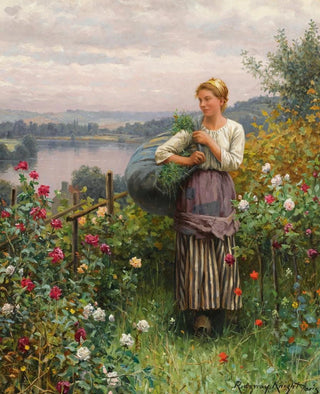Art print | The Rose Garden - Daniel Ridgway Knight


View from behind

Frame (optional)
In the enchanting world of art, some artworks manage to capture the very essence of beauty and serenity. "The Rose Garden - Daniel Ridgway Knight" is one of those creations that transports the viewer to a lush garden, where vibrant roses bloom under a azure sky. This painting, both delicate and vibrant, evokes an atmosphere of peace and contemplation. Through carefully chosen shades of color, Knight succeeds in evoking not only the splendor of nature but also a certain melancholy, a reflection on the passage of time. Immersing oneself in this work feels like an invitation to slow down, to appreciate the small wonders that surround us.
Style and uniqueness of the work
Daniel Ridgway Knight's style is distinguished by his ability to blend realism with a touch of idealism. "The Rose Garden" is no exception to this rule. The composition of the work is carefully orchestrated, each element placed with precision that demonstrates the artist's technical skill. The roses, symbols of beauty and passion, are rendered with such finesse that they seem almost tangible. The play of light and shadow adds an extra dimension, creating a dialogue between the flowers and the surrounding landscape. Knight thus manages to capture not only visual reality but also the emotion emanating from this idyllic setting. The color palette, ranging from vibrant roses to deep greens, contributes to the sense of harmony that emanates from the piece.
The artist and his influence
Daniel Ridgway Knight, an emblematic figure of the American Impressionist movement, established himself through his unique approach to painting. Born in 1839, he was deeply influenced by his travels in Europe, particularly in France, where he mingled with great masters of the time. His work is marked by a desire to celebrate nature and everyday life, themes that resonate particularly in "The Rose Garden." Knight succeeded in capturing the essence of the garden, not only as a physical space but also as a symbol of escape and dream. His influence continues

Matte finish

View from behind

Frame (optional)
In the enchanting world of art, some artworks manage to capture the very essence of beauty and serenity. "The Rose Garden - Daniel Ridgway Knight" is one of those creations that transports the viewer to a lush garden, where vibrant roses bloom under a azure sky. This painting, both delicate and vibrant, evokes an atmosphere of peace and contemplation. Through carefully chosen shades of color, Knight succeeds in evoking not only the splendor of nature but also a certain melancholy, a reflection on the passage of time. Immersing oneself in this work feels like an invitation to slow down, to appreciate the small wonders that surround us.
Style and uniqueness of the work
Daniel Ridgway Knight's style is distinguished by his ability to blend realism with a touch of idealism. "The Rose Garden" is no exception to this rule. The composition of the work is carefully orchestrated, each element placed with precision that demonstrates the artist's technical skill. The roses, symbols of beauty and passion, are rendered with such finesse that they seem almost tangible. The play of light and shadow adds an extra dimension, creating a dialogue between the flowers and the surrounding landscape. Knight thus manages to capture not only visual reality but also the emotion emanating from this idyllic setting. The color palette, ranging from vibrant roses to deep greens, contributes to the sense of harmony that emanates from the piece.
The artist and his influence
Daniel Ridgway Knight, an emblematic figure of the American Impressionist movement, established himself through his unique approach to painting. Born in 1839, he was deeply influenced by his travels in Europe, particularly in France, where he mingled with great masters of the time. His work is marked by a desire to celebrate nature and everyday life, themes that resonate particularly in "The Rose Garden." Knight succeeded in capturing the essence of the garden, not only as a physical space but also as a symbol of escape and dream. His influence continues






